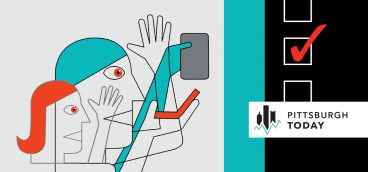Now That the Money’s Gone

As regional banks brace for another wave of small business loan applications, questions surrounding the emergency federal program are front and center after the first $349 billion quickly ran out.
Congress and the White House were reportedly near a deal late Monday that would add more than $300 billion to the Paycheck Protection Program, which offers businesses that employ fewer than 500 workers loans of up to $10 million that are forgiven if spent on employee wages and eligible benefits.
A cash infusion would offer hope to Pittsburgh businesses whose loans weren’t approved before the first-come-first-served program’s funds ran out. How many small businesses have PPP loans that have been approved by banks, but not funded is not clear.
The first tranche of PPP funding—part of the Coronavirus Aid, Relief and Economic Security Act—ran dry April 15 after the program encountered unprecedented demand that had banks scrambling to deal with an avalanche of applications for the novel relief loans.
Banks participating in the program accept and approve loan applications. Those they approve are sent to the U.S. Small Business Administration, which verifies them and allocates the money.
By the time the money ran out, “we had done more loans in 14 days than the SBA had done in 14 years,” said Kelly Hunt, director of the SBA Pittsburgh District. “It was like doing one year’s worth of loans a day, for 14 days.”
Next in line
The pipeline to PPP relief was closed when the money was exhausted and the SBA stopped accepting applications for the depleted funds.
Bank data on how many approved loans are waiting in the pipeline for a new round of PPP funding were unavailable.
Some banks that serve southwestern Pennsylvania businesses provided partial estimates of their activity. PNC, for example, said it processed and registered 20,000 PPP loans. Cleveland-based KeyBank said it processed 35,000 loans totaling $8.5 billion. Huntington Bank secured more than $6 billion in loans for its clients. Most banks serving the region have wider footprints and lend to businesses in several states.
Banks are required to close loans they approve and disburse the money within 10 days of the SBA verifying and registering the application.
Four of the 10 banks that serve the region did not respond to repeated requests for PPP data and their experiences with the program. None provided data showing how many businesses applied for PPP loans, a barometer of the scope of need among small businesses.
But a survey by the leading national small business association, NFIB, suggests that 70 percent of U.S. small businesses applied for PPP loans before the money was depleted.
If and when the program reopens, it will be up to banks to send previously approved loans that had been waiting in the pipeline to the SBA. The SBA does not maintain a queue.
Several banks in the region said they stopped taking new applications when the PPP money was exhausted in order to first process those it already has to get them ready to submit if and when new funding for the program is approved.
From the start, limited funding and the first-come-first-served nature of the program placed a premium on how efficient banks were at processing and approving loans for their clients under a program for which they had less than one week to prepare.
PNC, for example, said it leveraged “existing technology, operational know-how and the efforts of employees who worked around the clock to build an online portal to accept applications, collect required information and review applications.” First Commonwealth Bank said employees were reassigned and staff worked overnight at times to upload loan applications into the SBA system.
Most of the banks working the PPP loans have experience dealing with SBA loan programs. Some new banks reported issues with the computer system, which is the portal to the program, Hunt said. Most of the issues that banks reported to the Pittsburgh District “have been on the technical side, not the loan side.”
“This was a lot of work and it wouldn’t have happened without the help of the entire lending community,” said Hunt of the SBA. “I’m not going to tell you everything was perfect. But we were tasked to do something that had never been done before and we had five days to make that happen.”
Where it went
More than 69,500 PPP loans were approved for Pennsylvania small businesses from the first
round of funding. The $15.7 billion value of those loans is the sixth highest among the states,
according to the SBA.
Nationwide, 1.66 million businesses secured the loans. That represents 5.4 percent of the 30.7 million small businesses in the country.
Only 19 percent of U.S. small businesses have paid employees. The majority are single-person operations, such as sole proprietors, freelancers and others.
Construction businesses have received more than 13 percent of the PPP dollars so far, the most of any U.S. industry sector. Another nearly 13 percent of the loan funds went to companies in professional, scientific and technical services, a sector that ranges from engineering and computer systems to architectural and legal firms.
Manufacturing companies received about 12 percent of the loan money, as did health services and social services. Food services, which includes the hard-hit restaurant industry, received $30.5 billion, less than nine percent of the program’s loan money.
Small art and entertainment businesses received less than two percent of the PPP funds, as did newspapers, magazines and other businesses in the information sector.
Among the sharpest criticisms of the program is that certain large national companies, such as hotel and restaurant chains, were allowed to tap into the small business loan program if they employed no more than 500 per location. The outcry led one company, Shake Shack, a $1.6 billion burger-and-fries chain, to return the $10 million PPP loan it had been given.
The PPP loan program was intended to benefit workers at small businesses and nonprofits that would have difficulty obtaining credit elsewhere.
Whether the guidelines governing eligibility for the loans will be changed in new legislation seeking to replenish the program is uncertain. But the provision that allowed large companies to secure loans intended for small businesses has been criticized by both Republicans and Democrats in Congress.
Pittsburgh Today staff writers Julia Fraser and Bill O’Toole contributed to this article.





